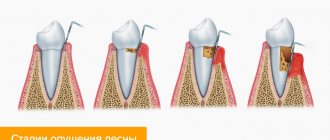Is it enough for a healthy person to only have toothpaste and brushes to take care of their teeth, is it really good to chew gum after eating, does sweets really spoil your teeth? We collected the most common myths about dental health and asked GMS Dental dentist Tatyana Anatolyevna Vinogradova which of them is true, and what not.
Sweets are bad for teeth
Is it true. And not only sweets
It all depends on the frequency of consumption of sweets and how long it remains in the mouth. If we quickly swallow one candy, then no disaster will happen - only extra calories will be added. But if we take some toffee, nougat or caramel and chew it for a long time, then this is where the risk of caries appears. When we eat something sweet, the pH environment in the mouth changes - it becomes more acidic, this worsens the condition of the teeth, they weaken and deteriorate faster. But, unfortunately, even a complete abstinence from sweets does not guarantee the absence of dental problems. Almost any food has a negative effect on teeth. Therefore, ideally, you should brush your teeth after every meal.
Chronic diseases
The main disease is caries. If left untreated, the tooth will collapse, as the superficial lesion gradually penetrates deeper, reaching the nerve. They can also get sick and deteriorate in the presence of certain chronic diseases:
- Diabetes mellitus provokes the development of periodontitis, which causes premature tooth loss and destruction of the jaw system. In diabetes, mineral metabolism in the body is disrupted, fluoride and calcium are washed out of it, and their deficiency leads to thinning of the enamel. As a result, bacteria quickly penetrate inside the tooth, destroying it.
- Osteoporosis affects not only the spine, but also the jaw bones on which the teeth are attached. The disease develops due to a lack of calcium, which is the main element in the structure of the skeletal system. Osteoporosis destroys periodontal tissue, causing gum disease, making gums soft and exposing tooth roots where bacteria can easily penetrate.
- Hypertension, for the treatment of which drugs that cause dry mouth are often prescribed. As a result, pathogenic microorganisms are not washed off by saliva, actively multiply, penetrating microcracks in the enamel, and increase the risk of caries.
- Gastritis with high acidity, changing the qualitative composition of gastric secretions and disrupting the absorption of phosphorus and calcium from it. Their deficiency leads to a decrease in the strength of the enamel.
The curvature of the spine also has a negative impact, which can provoke improper closing of the jaws, which leads to loosening and wear of teeth. It negatively affects the condition of the oral cavity and impaired metabolism, due to which the body does not receive the required amount of vitamins and microelements.
Chewing gum is good for your teeth
Is it true. But with reservations
Chewing gum works like an apple - it cleans your teeth. But you can snack on an apple, but not on chewing gum. In addition, it is important when you chew gum and how long you do it. If the gum does not contain sugar and you chew it for two or three minutes after eating, then yes, it is rather useful, it will clean your teeth and promote digestion. If you chew gum often, for a long time, or instead of eating, you can cause great harm to the stomach; in this case, the benefits for teeth are in doubt.
Poor nutrition
Proper nutrition affects both the entire body as a whole and its individual systems, including preventing the development of dental diseases. The most dangerous is the unreasonable consumption of carbohydrates, namely sugar-containing products, and their significant predominance in the diet.
To maintain dental health, it is recommended to include foods rich in:
- protein (meat, fish, eggs, milk), since its deficiency has an unsatisfactory effect on the accumulation of calcium;
- fluoride (seafood, fish, buckwheat, radishes, carrots), the optimal amount of which increases the resistance of tooth enamel to pathological factors;
- calcium (cabbage, nuts, fruits, dairy products), which has a positive effect on the crystal lattice of teeth.
In order to avoid negative effects on the jaw system, you should limit the consumption of sticky, viscous foods - toffee, chocolate bars, liquid caramel.
Such food sticks to the teeth, is poorly washed off by saliva, and contributes to the development of caries. You should not abuse sweet carbonated drinks and packaged juices, due to the high sugar content in them.
If your teeth look healthy in appearance and don’t bother you, then you don’t have to go to the doctor
Not true
This is our mentality: until something hurts, few people go to the doctor. And this applies not only to dentistry. This behavior is partly due to Soviet medicine, which is used to scare everyone. Partly, people simply don’t know where to go, don’t trust the doctor, are afraid to find out something unpleasant, and don’t want to spend money. But, of course, it is better to check regularly. You need to go to the dentist once every six months for hygienic cleaning, during which the doctor will use a special device to remove the plaque that you cannot remove at home and conduct a preventive examination of your teeth and oral cavity. This will allow any possible problems to be noticed and treated at an early stage and thus save money and time. After all, the longer you live with a problem, the longer and more expensive it will be to treat it.
Lifestyle and micronutrient deficiencies
To a certain extent, a person’s lifestyle affects the condition of their teeth. Thus, in people involved in certain sports (boxing, hockey), they are often injured, their integrity is compromised, a crack forms, and a crown or root fracture occurs. Because of this, the tooth becomes loose and its position in relation to the rest of the jaw changes.
A lack of vitamins and microelements causes hypovitaminosis, which is manifested by bleeding gums during the cleaning process. Most often, this happens in the winter-spring period, due to a lack of fresh fruits and vegetables.
To eliminate vitamin deficiency, you should take synthetic preparations that contain the required amount of all trace elements and minerals.
An electric toothbrush cleans better than a regular toothbrush.
Not true
I call these brushes brushes for the lazy. If you have an electric brush with a spinning head, I suggest throwing it away. She is not able to clean plaque. There is not enough power to rotate the head enough times. The trajectory of movement of such brushes only contributes to the fact that plaque ends up in the interdental space. If your electric toothbrush has a head that looks like a regular one, you can safely use this one. But still, it cannot be said that it cleans better than usual. They work the same way.
Genetic predisposition
The quality of teeth depends on what kind of teeth the parents had. Dental heredity can manifest itself both in children, during the formation of teeth, and in adults. It is not the specific disease that depends on genes, but the predisposition to it.
Heredity affects:
- tooth structure;
- jaw shape;
- metabolism in the body, which influences the occurrence of caries.
Studies have shown that if both parents had the first manifestations of caries on their lower teeth, then the same row will be weaker in the child. Scientists also found that if mothers had bad teeth, then 90% of children subsequently developed various dental diseases.
Deep fluoridation of tooth enamel
Deep fluoridation involves saturating tooth enamel with various minerals that prevent the development of caries. Fluoride-containing substances prevent the destruction of tooth enamel.
Main indications for the procedure:
- To prevent caries
- After installing the filling (to increase its service life)
- High sensitivity of teeth
- General strengthening of tooth enamel
- The need for bleaching and stain removal
- Caries in the active stage
Contraindications:
- Individual intolerance to fluoride-containing components
- Epidemic fluorosis
The procedure is completely safe and painless, but fluoride oversaturation is possible. To avoid this, stop using fluoride-containing medications, including toothpastes, before the procedure.
Main stages of deep fluoridation:
- Complete cleaning of teeth from tartar and plaque (professional cleaning of the oral cavity)
- Using special preparations, the oral cavity is dried with a warm air stream.
- A special sealing agent is applied and dried after a few minutes.
- Teeth shading is carried out - surface treatment of tooth enamel with a solution of copper and calcium hydroxide
Deep fluoridation of tooth enamel is an effective procedure, but its quality is inferior to enamel implantation with Innodent.
How to fix crumbling teeth
Once the cause is determined, treatment begins. If the condition of the teeth worsens due to diseases occurring in the body, the teeth are restored last - after other affected areas have been treated.
If the source of the problem lies in the oral cavity, the doctor may suggest several treatment options.
- Filling.
Caries or injuries lead to chips of varying sizes. They are removed with a filling.
- Crowns, veneers.
In case of serious damage to teeth, when filling does not help, it is recommended to install artificial crowns and veneers - porcelain or ceramic overlays.
- Mineralization.
A strengthening procedure during which applications containing calcium and fluoride are applied to damaged teeth.
- Fluoride coating of teeth.
The procedure also strengthens the enamel, but special fluoride-containing pastes are used.
- Taking multivitamins and nutritional supplements.
Installing veneers (onlays) is one of the ways to correct dental defects
When is a person to blame for having bad teeth?
Experts identify a number of causes of tooth decay, for which the patient himself is to blame. Knowing them, you can take timely measures to prevent the development of the disease. These reasons include:
- Smoking. Components released from tobacco disrupt metabolic processes in dental tissues. Due to this, their ability to resist adverse effects is sharply reduced.
- Alcohol, drugs. They negatively affect the functioning of the entire body, impair its protective functions and ability to recover.
- Poor nutrition. Lack of minerals and vitamins in food leads to weakening of the enamel. An excess of sweets, sour fruits, and berries contributes to the destruction of enamel.
- Unhealthy Lifestyle. Lack of physical activity, constant presence in dusty rooms, abuse of fatty, fried foods reduces the body's protective functions.
In addition, lack of or improper oral hygiene contributes to the formation of plaque. It becomes a source of food for microorganisms that gradually destroy teeth.
Enamel implantation with Innodent
The procedure is new, but has already proven itself as an effective method for restoring tooth enamel .
- Painlessly cures caries in 1 month
- Relieves tooth sensitivity
- Removes white spots after braces
- Strengthens and mineralizes enamel
Description of the procedure:
Innodent is applied to the tooth surface, which in turn is integrated into the enamel structure at the molecular level. This is achieved through active substances whose characteristics coincide with dental tissues.
Main results:
Cracks and damage to the enamel are completely eliminated, the integrity of the tooth enamel is restored and the process of regeneration of the natural structure begins.
When will the results of the procedure be visible?
You will see the first results 3 days after the start of the procedure, but the process of tooth enamel regeneration itself can last 1-1.5 months. A decrease in the sensitivity of enamel to mechanical and temperature stimuli also occurs gradually. In individual cases, it is possible to re-use the drug after 3-4 months.
Indications for the dental enamel implantation procedure
Below we will describe the main indications for which enamel implantation will be the most effective restoration method.
- High sensitivity of teeth (temperature and mechanical)
- Damage (chips) and cracks in tooth enamel
- Wedge-shaped defect (hyperplasia)
- Tendency of teeth to the spread of caries
- Pigment spots on the surface of tooth enamel
- At the initial stage of caries spread
An important feature of the drug is the possibility of use for preventive purposes, as well as in conjunction with teeth whitening procedures. Effectively copes with the treatment of enamel demineralization. It is possible to carry out the procedure after correction with braces in order to eliminate age spots on the surface of the enamel.
Are there any contraindications to the procedure?
The procedure is completely safe and has no contraindications as such. However, in rare cases, the following are possible: an allergic reaction and individual intolerance to one or more components of Innodent. You should not carry out the procedure with major damage to the internal tissues of the tooth.
Pros and cons of dental enamel implantation with Innodent
Main advantages:
- High degree of safety and natural ingredients
- Suitable for pregnant women and children (including baby teeth)
- As a result, you get smooth enamel with a natural shade
- Stains and damage are completely eliminated within a month
- Can be used at the initial stage of caries development and thereby avoid drilling and filling teeth
- Complete painlessness and absence of discomfort for the patient at all stages of the procedure
- The procedure is quick - about 15-25 minutes for everything
- The result lasts really long (from 1 to 3 years)
Flaws:
- Price - the method is not the cheapest, but in terms of price-quality ratio it has no analogues
- Really good results are possible a month after the procedure
- Does not solve the problem with large defects (internal tooth decay)
Dental implantation with the help of Innodent has allowed modern dentistry to truly restore enamel, and not replace it with temporary solutions.
A completely new approach to enamel restoration
Malocclusion
Malocclusion is diagnosed in the majority of the population. But, people go to the clinic for its correction only in case of a pronounced anomaly, although due to malocclusion the following occurs:
- Uneven load on teeth when chewing food. For some of them it is double the amount, while others are inactive. Due to excessive pressure, dental tissue is destroyed, leading to tooth loss.
- Reduced chewing activity, since not every tooth can participate in the process. To chew food well, you need to close your jaws tightly, but if you want to do this, discomfort and pain often occur. As a result, the composition of bone and soft tissue is disrupted.
An incorrect bite provokes the occurrence of an inflammatory process in the gums - periodontitis. In some people, due to an abnormal bite, involuntary grinding of teeth occurs - bruxism, which causes tooth wear and loosening.
What to do with a tooth that has rotted to the root?
If the root has rotted and treatment measures do not produce results, the tooth has to be removed. Loss of the upper part leads to the development of pathologies:
- the appearance of a cyst at the root apex;
- fracture or dislocation of the root;
- injury to the gums from a splinter;
- periodontal diseases.
A rotten root becomes a source of infection that spreads to nearby tissues.
In any case, the doctor chooses the treatment. If there is a high probability of negative consequences, removal will be carried out. To avoid this, it is recommended not to skip periodic dental checkups.
What symptoms appear with average caries?
To understand when a painful reaction to sweets occurs, you need to study the structure of the tooth a little.
In addition to enamel, the human tooth consists of dentin, and all dentin is penetrated by very thin dentinal tubules, which contain processes of odontoblast cells. These cells form the surface layer of the pulp and have their own sensitivity. They are the ones who react to sweets, they ate a piece of chocolate, the tooth ached sharply, but also quickly went away.
If only this sensitivity is present, then caries can be quickly cured, since the pulp has not yet been affected.
Composition and structure of tooth enamel
Tooth enamel is one of the strongest substances in the human body and completely covers the crown of the teeth. Under the layers of enamel there is dentin and a pulp chamber with a neurovascular bundle. A mixture of increased hardness made from collagen and calcium fibers (also called dental cement) covers the entire surface of the root system.
Composition of tooth enamel:
- 96% minerals, mainly calcium phosphate in the form of hydroxyapatite crystals
- 2% organic matter
- remaining 2% water
Strength of tooth enamel:
- Surface layers are the most durable and provide protection
- Cervical area and sides - density decreases
The average density on the chewing surface is 1.5 - 1.6 mm.
Habits that ruin your teeth every day
| Regular sweet snacks form plaque and destroy enamel |
| Biting foreign objects creates cracks |
| Bruxism: Teeth grinding at night causes tooth wear |
| Large amounts of citrus fruits: acid destroys enamel |
| Drinks with bright pigments stain tooth enamel |
| Improper brushing of teeth destroys enamel and injures gums |
| Frequent whitening with folk remedies destroys enamel and increases sensitivity |
If you take several x-rays in a row, you can get high levels of radiation
Reality: According to one of the leading specialists in dental radiology, D.V. Rogatskin, one intraoral photograph of a tooth corresponds to approximately one microsievert.
The radiation dose when taking one three-dimensional image on a dental tomograph is approximately equal to the radiation dose from a panoramic image and is about 20-50 microsieverts. What to do?
You should not apply to a peaceful dental office the same concepts that are used at a nuclear test site. During the treatment process, you can and should take as many x-rays as your doctor needs, and if necessary, do not be afraid to do 1-2 studies per year on a dental tomograph. It is necessary to understand that your attending physician takes a picture, or a series of pictures, so that the quality of treatment is at the proper level and the tooth will serve you for many more years. And such a modern method as tomography of the maxillofacial area goes beyond the boundaries of conventional x-ray examination and often allows the doctor to see in volumetric form the pathology that cannot be determined on ordinary photographs.
When is it time to sound the alarm? Symptoms and stages of tooth decay
There are a number of signs that should alert you. Having noticed one or two of them, a person should become concerned and see a specialist. This:
- 1. Accumulation of plaque on tooth enamel. Barely noticeable yellowish spots.
- 2. Bad breath, even the smell of rotten breath. With severe caries, the smell will be very noticeable.
- 3. Dark spots on the enamel. Painful sensations when eating hot or cold, sweet foods.
- 4. If you ignore the above-mentioned manifestations of ill health, the situation gets worse. Next, black areas appear in the area of the neck of the tooth or on the root itself, but the latter can only be detected during an X-ray examination.
- 5. Frequent aching painful sensations appear, and even if you regularly rinse your mouth with herbal infusions and take painkillers, the destructive processes are in full swing.
- 6. The pain intensifies (especially when a stream of cold air hits the tooth), and the pulp begins to die.
- 7. The nerve bundle is affected, the pain becomes especially severe.
- 8. Then, if the person never went to the hospital, he notices with surprise and relief that the pain goes away. However, in reality, the inflammatory process does not stop - the disease spreads to the root area.
Professional methods for restoring tooth enamel
In most cases, damaged enamel requires professional restoration at a dental clinic. There are many methods, we will look at the most popular ones, as well as an innovative method of restoring teeth using the drug Innodent Repair .
Remineralization
Remineralization ensures restoration of the structure of tooth enamel by stabilizing the balance of minerals present in tooth enamel. Professional remineralization in a dental clinic is carried out using products and preparations containing fluoride and calcium.
Main indications for the procedure:
- Loss of natural shine on teeth
- Lack of surface mineralization
- Development of carious enamel damage affecting the internal tissues of the tooth
- Toothache when eating high or low temperature foods, as well as sweet and sour foods.
The remineralization procedure occurs by coating the enamel with a special preparation containing the necessary complex of minerals necessary to maintain the integrity of the teeth’s incisors.
As a rule, it includes: ionized fluorides, components that increase the protective properties of enamel, phosphorus, zinc and calcium.
Why do teeth rot at the gums?
Caries near the gums and on visible parts of the tooth are no different.
The reasons for its occurrence are the same, but near the gums it is more difficult to identify and treat the disease. Therefore, patients usually consult a doctor at the stage of progressive pulpitis. Timely detection helps prevent the development of caries in the gingival region. To do this, you need to periodically visit the dentist, who will correctly assess the condition of the enamel and detect the development of caries in time. Experts call gum disease a common cause of its occurrence. Food debris that accumulates in the gum pocket promotes the development of bacteria. In addition, the disease can be caused by an incorrectly installed crown, poor hygiene, or changes in the composition of saliva.











